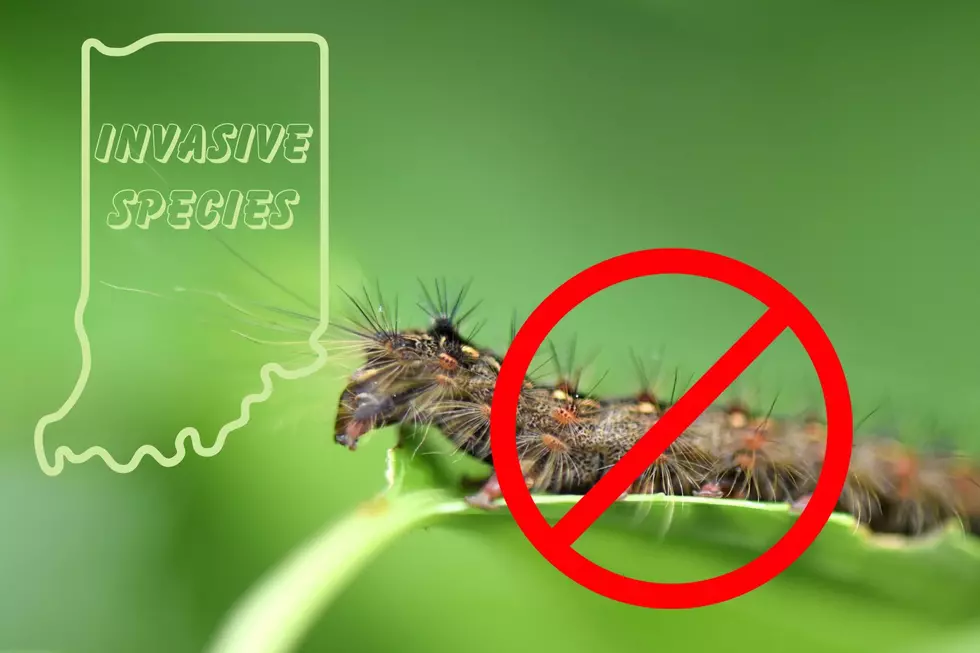
Use This Simple DIY To Rid Your Trees of this Invasive Indiana Caterpillar
Once known as the gypsy moth, spongy moths are an invasive and destructive species found in Indiana and other parts of the United States. Fortunately, you can help eliminate them, and it's an easy DIY.
Spongy Moths Defoliated More Than 9 Million Acres of Forest in 2021
Purdue University calls spongy moths the "most serious forest defoliator" in the country. In 2021 alone the invasive pest defoliated more than 9 million acres of forest in the United States. The popular favorite of spongy moths is oak leaves. However, they can and do consume the leaves of 500 different species of trees and plants. Spongy moths were introduced to the United States in 1869 on accident, and have since become a widespread pest. They were first identified in Indiana in 1998.
READ MORE: This Morbidly Named Mushroom is Found in Indiana
Female Spongy Moths Will Lay Eggs Just About Anywhere
There are four phases of the life cycle of a spongy moth. They begin as eggs, growing into caterpillars, then becoming pupa before emerging as adult spongy moths. A female will lay an egg mass on any surface that is convenient - firewood, tree branch, car, picnic table, etc. The following spring the eggs will hatch and caterpillars will emerge, ascending to the tree tops.

Spongy Moth Caterpillars Have Voracious Appetites
It's here that they eat and they are voracious. They may also dangle on silk threads that allow the caterpillars to be blown to other trees. Purdue University describes the molting process and what the caterpillars look like in their final form before moving into the pupa stage.
<p>After establishing themselves on a tree, caterpillars molt into a second instar that is nearly 1/2-inch long and largely black, with irregularly shaped yellow marks visible on the upper body surface. Older caterpillars (4th - 6th instars) have distinct color markings on their backs, with five pairs of blue dots followed by six pairs of red dots</p>
Spongy Moth Caterpillars Do Not Make Cocoons
As they transition into their third stage as pupae, the caterpillars will stop eating, usually around early June. Spongy moth pupa are dark brown and look like a shell. They do not make cocoons.
READ MORE: This Indiana Plant is Invasive and Edible
Adult Spongy Moths Emerge in July and August
When they emerge in July and August in their adult form, the female spongy moths have tan bodies with creamy white wings. The males are smaller in size, and dark brown in color. Females cannot fly and both male and female spongy moths have very distinct markings on their wings. They look like an upside down letter V pointing to a dot.
Elimination of Spongy Moths Is Not Possible but Slowing Their Spread Is
While total elimination of spongy moths is not possible according to Purdue University, it is possible to slow their spread. That's where you come in. If you plan to move from an area known to be infested with spongy moths to an area that is not, you should perform an inspection of your belongings before making that move, as outlined by the USDA.
How To Band a Tree to Capture and Dispose of Spongy Moth Caterpillars
If you are trying to maintain population control on your own trees, you can wrap a band of burlap around the trunk of the tree. Purdue recommends that you use burlap or another sturdy, dark color material that is 12 to 18 inches wide, and long enough to wrap the entire circumference of the tree. Wrap the material around chest-height, and secure at the midpoint with string or twine. Fold the top of the material over to meet the bottom. This creates a sort of trap to capture the caterpillars as they climb the tree.
READ MORE: The Pesky Seeds From This Native Indiana Tree are Edible
Spongy Moth Caterpillars Can Be Submerged in Soapy Water
In the afternoon, you can remove the caterpillars from the makeshift trap and drop them into a bucket of soapy water - use dish soap. Once they have been in the soapy water for a day or two to ensure they are no longer alive, you can dispose of them. You can see an example of a burlap band in the photo above from Elkhart County Parks as they work to minimize the impact of the spongy moths.
Working to Slow the Spread of Spongy Moths in Indiana
Again, this method will not eradicate them completely, but it will help to slow their spread. To learn more about spongy moths and their management, including a diagram detailing the trap mentioned above, visit Purdue University's guide.
Beautiful Photos from Popular Kentucky and Indiana Hiking Trails
Gallery Credit: Mary-Katherine Maddox
